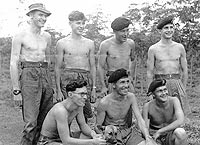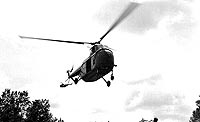Malaya 1955

(Click to enlarge) |
On the night of 3rd January it was reported that the CTs were going to move the food. 'Cut Off' parties stood by, and at last light 'D' Company the main assault party, went forward to the food dump. The moment firing was heard, 'A', 'B', and 'C' Companies moved into position, while two armoured car troops of the 4th Hussars and Federation Armoured Car Regiment together with the Battalion's own MMG and Mortar Platoons brought fire to bear on the one area, a large swamp, not covered by the cordon. Meanwhile RAF Sunderland flying boats were called in and dropped flares for the rest of the night to illuminate the scene in conjunction with two RA searchlights close to the village. Results were not as good as anticipated; only two CTs fortunately the most important ones, were killed, and four surrendered later, which eliminated that particular CT Branch. In fact only 14 CTs had been engaged as luckily for them the CT 'No. 5 Platoon' had not arrived on time.
In January virtually the whole Battalion was in the jungle. Early in the month, 'Meiktela', a deep jungle base of Company strength, was taken over from 2/6 Gurkhas until relieved by helicopter in April. At the end of the month 2 Platoon of 'A' Company and 5 Platoon of 'B' under Major P R Swanson, located a terrorist camp on Mount Ophir - a tricky operation as the guide completely lost his way to the almost inaccessible site in precipitous jungle. Nevertheless surprise was achieved and two 'CTs' killed.
In February and March attention was increasingly switched to the Malacca area, which had been proclaimed the first 'White Area' as the result of a progressive policy to 'normalise' civilian activity in areas where terrorist influence had been greatly curbed, but to which CTs were transferring their activities due to the unrelenting pressure on Mount Ophir. Reacting to this development involved constant patrolling and one combined 'C' & 'D' Companies' operation.
On the 25th March, at the completion of the Battalion's first operational year, twenty-eight CTs had been killed, and nineteen caused to surrender.
In April, Operation 'Mentor' involved encirclement during a dark and stormy night, of Sagil, a 'new village' South of Mount Ophir where it was known a terrorist store of food had been collected. One CT Committee Member was killed. Further incidents occurred in the Malacca area when the CT '5 Platoon' attacked Police patrols, and the Battalion's Companies including most of HQ Company were out frequently, but caught no terrorists.
South Johore & Singapore
At the end of April, 'A' Company (Major J B C Palmer) and 'C' (Lieutenant T G Mulady) moved South to Kota Tinggi and Pengerang respectively, and were immediately involved in a combined Services Operation 'Rex' against 'CTs' in the Pengerang peninsular - thick jungle and swamp, and wide open to illegal emigration and food running from nearby Singapore Island; there were virtually no roads so the two Companies were moved and supplied by launch, and supported by RAF bombing and fire from RN and Royal Malayan Navy ships.
 |
|
| S55 helicopter. (Click to enlarge) |
|
At the end of May the rest of the Battalion relieved by 2nd Battalion Royal Welch Fusiliers, moved to the Kluang area, to be rejoined six weeks later by 'A' and 'C' Companies. The new area was even more active than the previous one - frequent murders, ambushes and attacks on the local Home Guard. There was constant patrolling, but the CTs were elusive, and only one was killed in the first month of operations.
'A' and 'C' Companies were deployed with a platoon each in six of the most uncooperative 'new villages', keeping in check Communist influence and gaining the confidence of the villagers. 'D' Company (Major Lowry) was flown into deep jungle to ambush 'CTs' in jungle cultivations, while 'B' Company (Major Swanson) patrolled in the Rengam area achieving the one 'kill' of the month.
At the end of June the Battalion moved to Selarang Barracks to retrain and to take over Internal Security duties in Singapore. This phase lasted through July and August, and finished with a parade before Major General R N Anderson, GOC 17th Gurkha Division, when the Battalion with a total strength of about 900, mustered 550 all ranks on parade, the capacity of the barrack square.
On the 9th September the Prime Minister of the newly elected Government of Malaya, Tunku Abdul Rahman, declared an amnesty for the CTs on most favourable terms, and military activities were drastically reduced. However, very few Communist surrenders took place, and in the Kluang and Rengam areas, hostile incidents actually increased. General Sir Geoffrey Bourne, Director of Operations, therefore ordered a strong concentration of troops to confront them. 1st Queen's was to operate in the Rengam area, in cooperation with other units, including 1st Northern Rhodesia Regiment commanded by Lieutenant Colonel G H W Goode (Queen's). The two Battalions had a common tactical boundary, the Queen's operating in the estates and the Northern Rhodesians in the jungle.
The Queen's were responsible for five 'new villages', a large number of estates, and patches of jungle between. This involved long patrols from dawn until after dark, perpetually checking workers and villagers, searching vehicles and buildings for surplus food, and dealing with incidents often at night. These activities were successful in sapping the strength of the Rengam Communist Branch, whose members were reduced to living on oil palm nuts and tree shoots. There were vast oil palm estates in the south of the Battalion area near Layang Layang, and as far as possible these were denied to the 'CTs' by mortar and MG fire on the approaches, and by constant patrolling, some on bicycles.
Related
